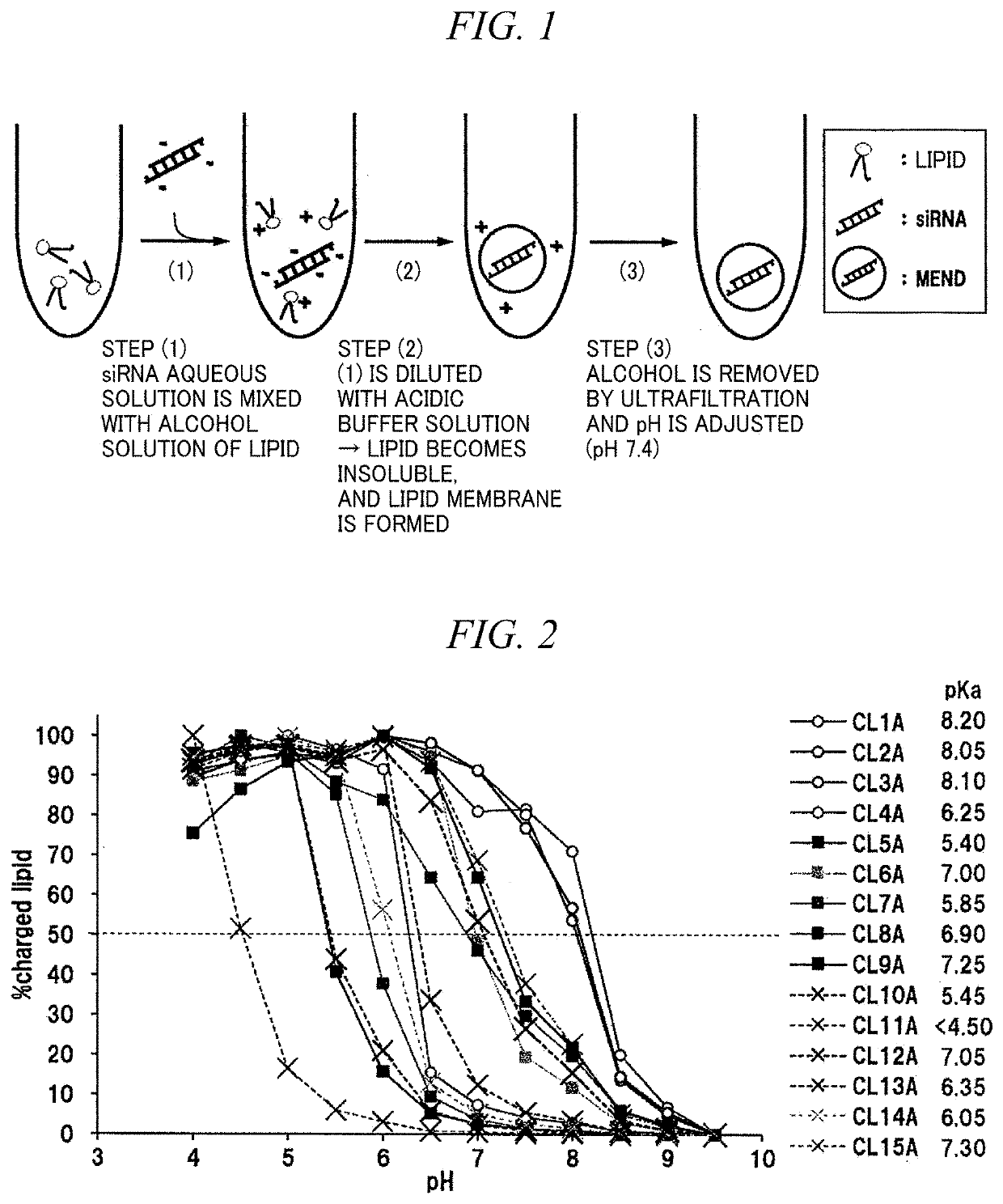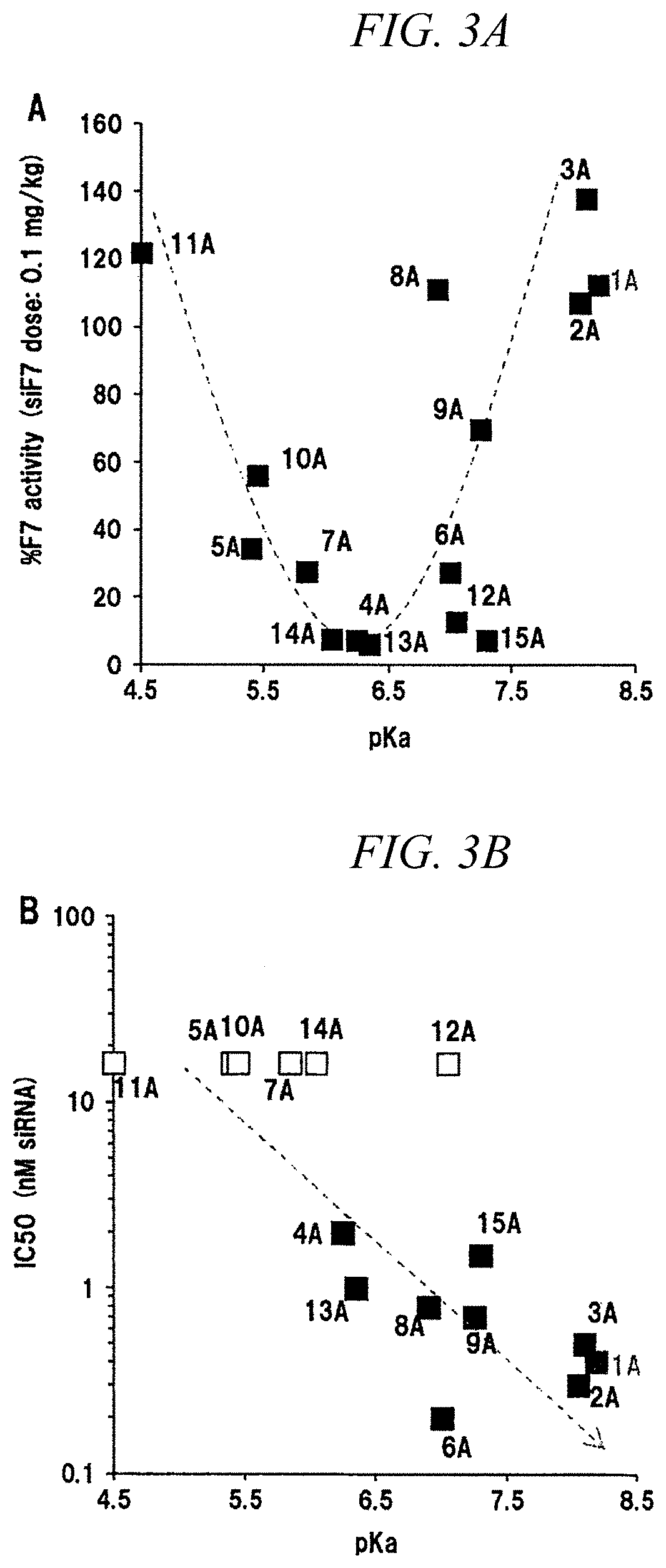LIPID MEMBRANE STRUCTURE FOR DELIVERY INTO siRNA CELL
- Summary
- Abstract
- Description
- Claims
- Application Information
AI Technical Summary
Benefits of technology
Problems solved by technology
Method used
Image
Examples
example 1
[0145]The lipid compound of the present invention was synthesized according to the following scheme. In a case where a hydrophobic scaffold is the same as that of YSK12 (Patent Literature 6), that is, in a case where a lipid in which c in General Formula (A) is 0 is synthesized, a linoleic acid (a compound A) was used as a starting material. A linoleic acid was reduced with lithium aluminum hydride (a compound B), activated by mesylating a hydroxyl group (a compound C), and brominated by the action of magnesium bromide (a compound D). Two linoleic-acid-derived hydrophobic scaffolds were linked by performing the Grignard reaction using 6-valerolactone as a substrate (a compound E). In a case where a tertiary amino group was directly bonded to a hydrocarbon chain, a primary hydroxyl group was activated through tosylation (a compound F), and the amino group was introduced by a nucleophilic substitution reaction.
[0146]Meanwhile, in a case where a tertiary amino group is bonded via an es...
example 2
[0256]A pH-sensitive cationic lipid which has various hydrophilic sites and in which a hydrophobic scaffold was derived from a linoleic acid was evaluated. In accordance with the method of the examples (Example 2) of Patent Literature 6, LNPs were prepared by mixing respective pH-sensitive cationic lipid, cholesterol, and methoxy polyethyleneglycol 2000 dimirystoylglycerol (PEG-DMG 2000) at a molar ratio of 50:50:0.75 to 1.5 by an alcohol dilution method (FIG. 1). An average particle diameter calculated by a phase light scattering method was 80 to 120 nm, and an siRNA loading rate was 90% or more.
[0257]A pKa of each LNP was obtained using p-Toluenesulfonic acid (TNS). TNS's (final concentration: 0.75 μM) and LNPs (final concentration: 30 μM) were mixed in a buffer solution adjusted to each pH, and a fluorescence intensity was measured with a microplate reader. The highest value and the lowest value were respectively calculated as 100% and 0% charge, and a pH showing 50% of a charge ...
example 3
[0260]An influence of changing a chemical structure of a hydrophobic scaffold was evaluated in the same manner as in Example 2 by fixing a hydrophilic site to two kinds of compounds, which are CL4 and CL15. When a pKa was measured using TNS, it was 6.25 to 6.40 for CL4 and was 6.80 to 7.25 for CL15, which shows that they were not affected by change in hydrophobic scaffold structure (FIGS. 4A and 4B). Regarding the in vitro knockdown activity, other derivatives except CL15B had superior activity than that of CL15A having a hydrophobic scaffold of the related art (FIG. 5). In particular, CL15H, which has an oleic acid as a hydrophobic scaffold, showed about three times higher activity than that of CL15A. Regarding the in vivo F7 knockdown activity, the activity of the hydrophobic scaffolds C and D was low for both CL4 and CL15, whereas a hydrophobic scaffold H showed the same or higher activity than that of the hydrophobic scaffold A (FIGS. 6A and 6B).
[0261]Regarding CL4H which showed...
PUM
| Property | Measurement | Unit |
|---|---|---|
| Fraction | aaaaa | aaaaa |
| Fraction | aaaaa | aaaaa |
| Fraction | aaaaa | aaaaa |
Abstract
Description
Claims
Application Information
 Login to View More
Login to View More - R&D
- Intellectual Property
- Life Sciences
- Materials
- Tech Scout
- Unparalleled Data Quality
- Higher Quality Content
- 60% Fewer Hallucinations
Browse by: Latest US Patents, China's latest patents, Technical Efficacy Thesaurus, Application Domain, Technology Topic, Popular Technical Reports.
© 2025 PatSnap. All rights reserved.Legal|Privacy policy|Modern Slavery Act Transparency Statement|Sitemap|About US| Contact US: help@patsnap.com



